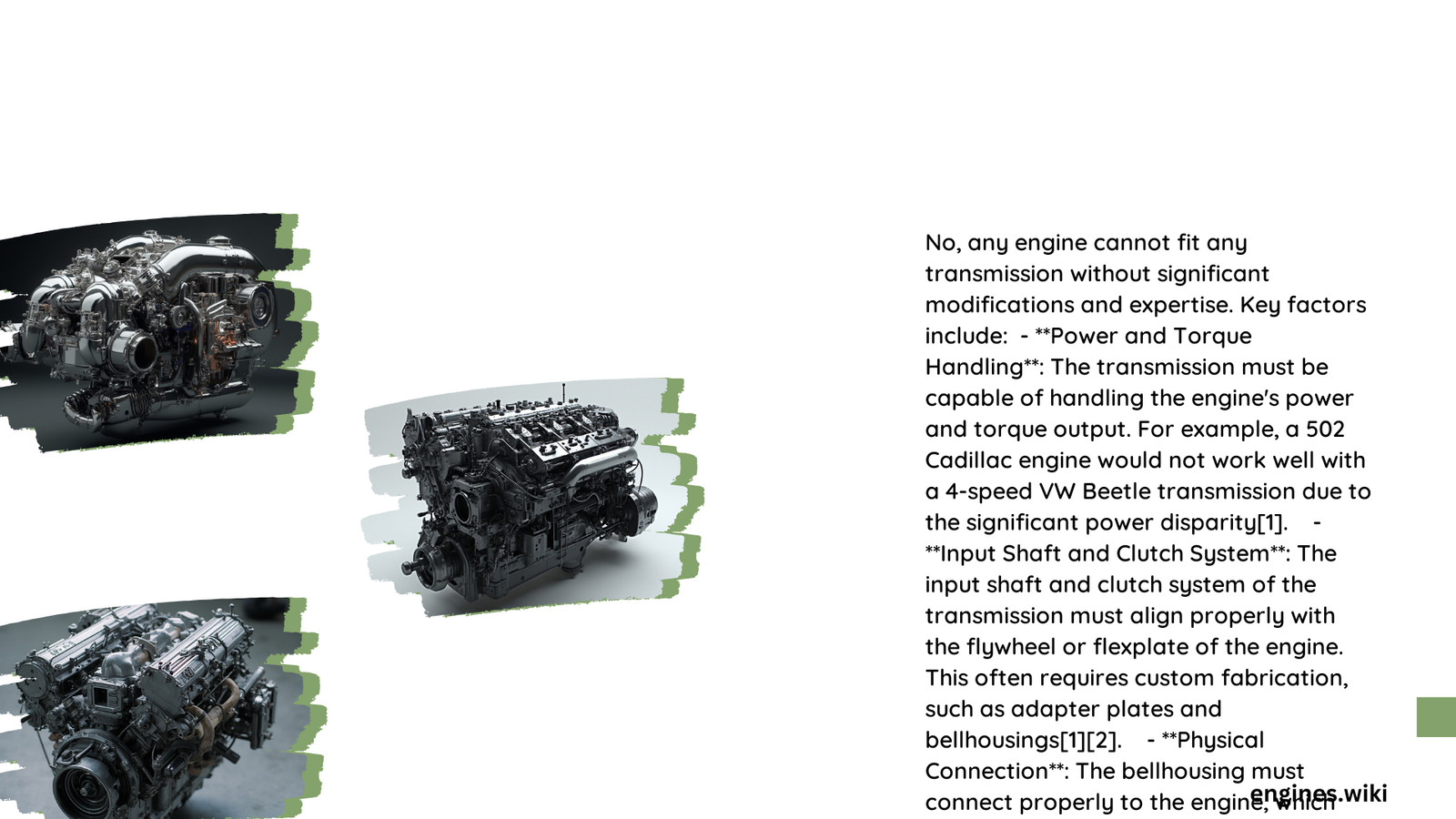Engine and transmission compatibility is a complex topic in the automotive world. While it’s theoretically possible to connect any engine to any transmission, practical limitations and engineering challenges make this unfeasible in most cases. This guide explores the intricacies of engine-transmission compatibility, focusing on the factors that determine whether a specific engine can work with a particular transmission.
What Determines Engine-Transmission Compatibility?
Several key factors influence whether an engine can be paired with a transmission:
- Physical dimensions and mounting points
- Bellhousing patterns
- Spline count and diameter
- Torque capacity
- Electronic compatibility
Let’s delve into each of these factors to understand their importance in engine-transmission compatibility.
How Do Physical Dimensions and Mounting Points Affect Compatibility?
The physical size of the engine and transmission, along with their mounting points, play a crucial role in determining compatibility. Here are some key considerations:
- Engine bay space: The engine and transmission must fit within the vehicle’s engine bay without interfering with other components.
- Mounting locations: The engine and transmission mounts must align properly with the vehicle’s frame or subframe.
- Driveshaft length: The combined length of the engine and transmission must allow for proper driveshaft fitment.
Example Dimensions for Popular Engines:
| Engine Type | Width (in) | Length (in) | Height (in) | Weight (lbs) |
|---|---|---|---|---|
| Chevy Small Block V8 | 26 | 28 | 27 | 575 |
| Ford Windsor V8 | 24 | 29 | 27.5 | 460 |
| Chrysler LA V8 | 24 | 29 | 27 | 550 |
What Role Does the Bellhousing Pattern Play?
The bellhousing pattern is a critical factor in engine-transmission compatibility. It refers to the bolt pattern that connects the transmission to the engine. Common bellhousing patterns include:
- Chevrolet (GM) pattern
- Ford pattern
- Chrysler pattern
- Import patterns (e.g., Honda, Toyota)
Mismatched bellhousing patterns will prevent the engine and transmission from connecting properly. However, adapters are available for some combinations to allow cross-brand pairings.
How Does Spline Count and Diameter Affect Fitment?
The input shaft of the transmission must match the clutch or torque converter of the engine in terms of:
- Spline count
- Spline diameter
Mismatched splines will prevent proper engagement between the engine and transmission. Some common spline configurations include:
- 10-spline
- 23-spline
- 26-spline
- 30-spline
What Is the Importance of Torque Capacity in Transmission Selection?
The transmission must be capable of handling the engine’s torque output. Using a transmission with insufficient torque capacity can lead to premature failure. Consider the following:
- Stock transmissions are typically rated for the original engine’s torque output
- High-performance or modified engines may require upgraded transmissions
- Automatic transmissions often have lower torque capacities than manual transmissions
How Does Electronic Compatibility Impact Modern Engine-Transmission Pairings?
In modern vehicles, electronic compatibility is crucial for proper engine-transmission function. Key considerations include:
- ECU compatibility: The engine control unit must be able to communicate with the transmission control module (if present).
- Sensor integration: Speed sensors, position sensors, and other electronic components must be compatible and properly integrated.
- Wiring harness: The wiring harness must accommodate both the engine and transmission connections.
What Are Common Engine-Transmission Compatibility Scenarios?

Let’s explore some common scenarios to illustrate engine-transmission compatibility:
Can a Chevrolet Engine Work with a Ford Transmission?
While not a direct fit, it is possible to pair a Chevrolet engine with a Ford transmission using an adapter plate. However, this combination may require:
- Custom bellhousing or adapter plate
- Modification of the flexplate or flywheel
- Potential driveshaft modifications
- Custom wiring for electronic controls (in modern applications)
Is It Possible to Use a Manual Transmission with an Engine Originally Paired with an Automatic?
In many cases, yes. This swap typically requires:
- Changing the flexplate to a flywheel
- Installing a clutch assembly
- Modifying the transmission tunnel (in some cases)
- Updating the ECU programming (for modern vehicles)
Can Diesel Engines Be Paired with Gasoline Transmissions?
While possible, pairing a diesel engine with a gasoline transmission often requires significant modifications due to:
- Different torque characteristics
- Varying bellhousing patterns
- Potential differences in electronic controls
What Are the Steps to Determine Engine-Transmission Compatibility?
To determine if a specific engine can fit a particular transmission, follow these steps:
- Research the original engine-transmission pairings for both components
- Compare physical dimensions and mounting points
- Check bellhousing patterns and spline configurations
- Verify torque capacity of the transmission
- Assess electronic compatibility (for modern vehicles)
- Consult with experts or enthusiasts who have attempted similar swaps
- Consider the availability of aftermarket adapters or conversion kits
What Are the Challenges of Non-Standard Engine-Transmission Pairings?
While it’s technically possible to connect many engines to various transmissions, non-standard pairings often present significant challenges:
- Custom fabrication requirements
- Increased complexity and cost
- Potential reliability issues
- Difficulty in tuning and optimization
- Legal considerations (emissions and vehicle registration)
Conclusion: Can Any Engine Fit Any Transmission?
In conclusion, while it’s theoretically possible to connect any engine to any transmission, practical limitations make this unfeasible in most cases. Compatibility depends on physical fitment, mechanical interface, torque capacity, and electronic integration. While aftermarket solutions exist for many combinations, non-standard pairings often require significant expertise, custom fabrication, and potential compromises in performance or reliability.
For the best results, it’s advisable to stick with proven engine-transmission combinations or consult with experienced professionals when attempting custom pairings. Always consider the legal implications and potential impact on vehicle safety and performance when modifying drivetrain components.
